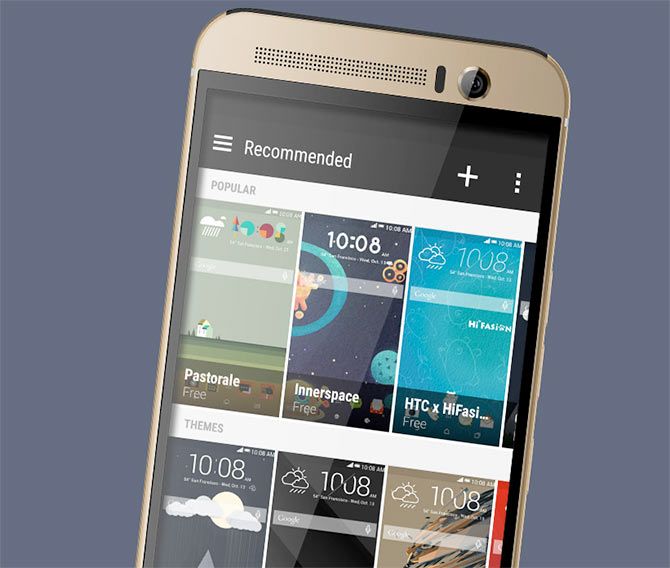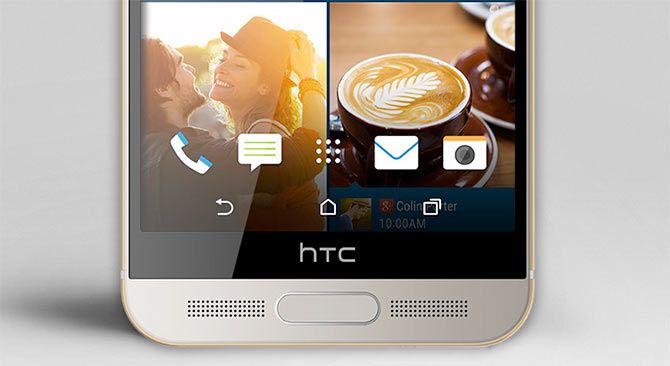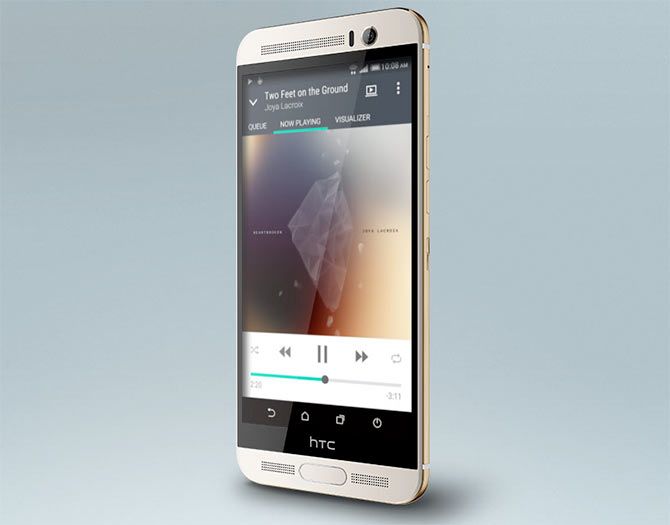HTC has always wowed the audience with its slick and beautiful designing of its phones. Anybody taking a look at HTC One M9+ will not think otherwise either.

Photographs: Courtesy, htc.com
It has been long established that HTC produces some of the best designed and aesthetically beautiful mobile phones in the business. Maintaining the streak, HTC recently launched another stunning piece of hardware in India in the form of HTC One M9+.
The phone clearly has the family resemblance; as similarity with HTC One M8 is pretty much apparent, but there are improvements as well, mainly with the grip.
While the phone is packing a solid configuration under the hood, the old school designing doesn't really look too inspiring or fresh with the current times.
Given the fact that HTC intends to pitch the HTC One M9+ against the likes of Samsung Galaxy S6 and Apple's iPhone6, it remains to be seen how buyers will view a phone which intends to ride heavily on HTC's reputation.
Time to take a closer look at what constitutes the new One M9+ from HTC.
Design

HTC has always wowed the audience with its slick and beautiful designing of its phones. Anybody taking a look at HTC One M9+ will not think otherwise either.
However, it does seem like the company went ahead and played it safe by going in with the same design scheme rather than trying something more innovative.
Nonetheless, One M9+ is a beautiful looking device, and measures 5.94 x 2.83 x 0.38 inches dimension wise. At 168 gms, it is not heavy either.
The phone's aluminium back carries brushed finish texture, and the top panel gives the impression of being stacked atop the lower one. The panels are not flush with each other, and the edges have been imparted a mirrored finish to create a sort of different aesthetic feel.
The step design provides a good grip, and the device feels solid when held.
HTC has made the entire top edge of the phone catering to the IR blaster. It has placed the power button on the right side of the phone, and has given two buttoned volume rocker to give it company. There is also the micro SD card slot on the same side as well. On the left edge one finds the nano SIM tray. The bottom edge carries the 3.5 mm jack, as well as the micro USB port.
Must mention here that the power button and the volume buttons are pretty similar. But thanks to concentric circle pattern on the power button, users should eventually get used to it.
Something to delight the users is the fact that HTC has incorporated a finger print scanner into the home button, much like Samsung and Apple, with this model.
As a result, the lower segment of the front BoomSound speakers are split into two. Thankfully, the phone doesn't look awkward. And just one more thing: the BoomSound speaker now comes with Dolby sound technology, making them sound even sweeter.
Display

Equipped with a 5.2-inch super LCD3, the phone has been provided with a QHD display with a resolution of 1440 x 2560 pixels. The pixel density translates to about 565 ppi, which is tremendous. The HTC One M9+ also carries the Gorilla glass 4 for better resistance against scratches and minor tumbles.
The display is bright with fabulous viewing angles. Something which will delight many HTC ardent fans and/or observers is the fact that the visibility during outdoor experience has been enhanced as well. The scintillating pixel density ensured that the text looked sharp.
While the colours looked decently saturated with their hues, the display overall looks pretty much in line with the expectations.
Hardware
The M9+ comes with a Mediatek MT6795T chipset, carrying an octa core processor clocked at 2.2GHz. The graphics are churned out with the help of PowerVR G6200 GPU.
Something which brought an instant smile to the face was the presence of 3GB RAM onboard.
The phone comes with 32GB internal memory and provides the advantage of further enhancing the storage capacity with 128GB via Micro SD card.
Software

The HTC One M9+ comes with HTC sense 7, which is based on the Android Lollipop OS (ver 5.0).
The Sense skin evolution is not too diverse here from Sense 6 days, and the ones really worth mentioning is that how HTC incorporated Sense home, the theming options, and of course the material design.
The Sense home first is basically a widget which intelligently senses the location of the user and brings up apps based on that information. This Sense home basically serves to provide a way to quickly access the shortcuts, apps, and folders which are frequently used in a particular environment.
This feature shows similarity with Yahoo's Aviate launcher with its predictive powers, thus taking away a little sheen off it.
The other feature, the theming option, has been provided to allow users to tweak the phone's look and feel according to personal preferences. Users get to modify the appearance by changing wallpaper, font icon packs etc. There are themes available for download, and if that is not enticing enough, the users have the freedom to create their own themes as well.
The fingerprint sensor appended into the home button is promising as it provides not only instant unlocking ways, but the potential for future usage also is something to look forward to. The sensor reads the fingerprints in any orientation, thus providing with a distinct advantage of going for the unlocking act as soon as the user is in a position to attempt so.
Performance

The phone has one of the better configurations around and it wasn't anything surprising that the performance reflected and confirmed that potential. There wasn't any lag noticed while dealing with heavy content like HD videos, games or multitasking etc.
The apps fired up and closed with aplomb and navigating in general through the phone was a breeze. There were no stutters or hiccups either.
The BoomSound speakers are always a huge plus with the HTC phones, and with Dolby technology, HTC One M9+ provides an experience which is superior to others to the extent of being absolutely unmatched. However, the loudness level could have been a notch higher. How this little detail missed HTC Labs is something surprising to say the least.
Like the minor issue with the sound levels, another minor yet mentionable issue happens to be the heating one. The phone does get hot while dealing with CPU intensive tasks like playing taxing games, watching heavy video files. The heat dissipation needed to be looked into and HTC ought to make sure this doesn't become a habit with future models.
As already mentioned, the finger print scanner on the home button works, and works nicely too.
Camera

Rarely anybody would mention the front facing camera first to give company a credit, but HTC probably played a real masterstroke by placing its much touted Ultra Pixel camera technology with the 4MP front facing camera.
If you are one of those selfie enthusiasts, this camera right here will appeal to you. The results are very impressive, and the bigger pixels capture that many more details and this is particularly true for not so well lit conditions. Seems like the Ultrapixel technology has finally found its permanent home with HTC phones. A wide angle lens and HDR enabled status only enhances its profile.
As for the rear camera, HTC has gone with 20MP lens along with a 2.1MP depth sensor. A dual-LED, dual tone flash completes the setup.
The depth sensor camera is responsible for gauging the depth and render effects. The app allows to choose from either high resolution mode, or duo mode, the latter mode employing the services of both the cameras.
The pictures captured here during the day were pretty good but definitely not in the same class as say Samsung Galaxy S6, which now holds the benchmark status for android phones.
The pictures at times suffered with exposure issues. The level of details again wasn't very satisfying either, with occasional instances where noise creeped in.
The pictures are more than passable but that HTC would not solve these issues for a flagship phone was mind boggling.
The pictures clicked indoors didn't gave the natural look despite the dual tone LED setup. This was not expected to say the least. But in general, the quality was just about good and colour reproduction levels were decent.
To sum up, the rear camera really flattened HTC M9+'s impressive run till now.
Battery
The M9+ comes with a 2840 mAh Li-Po variant battery, and it was a bit disappointing to see that HTC decided to go with a non removable type.
The battery performed admirably well in real world testing scenario. With a moderate to heavy usage pattern, the battery lasted little over a day and hence gave ample time for the user to juice up the battery for a fresh start the following day.
In addition to this, there is the extreme power saving mode as well. This mode, as claimed by HTC, makes the battery offer two weeks' worth of stand by time.
It achieves this by restricting the data running in the background while reducing the phone for only essential services like making/receiving calls, messaging, mail, calendar etc.
The extreme power saving mode also delivers 30 hours of talk time, providing the phone an impressive mentionable in its resume.
Verdict
The phone overall is good and shows promise with smooth performance, top-notch build quality and more feature-rich version of HTC's Sense UI, but with just about average rear camera, and lacklustre design elements, one finds it difficult to digest that HTC would call it a true flagship device.
There is no doubt that the One M9+ is not exactly the sort of upgrade one expects from M8 to another flagship device and hence users already on the HTC One M8 would rather skip it. The phone is a case for consideration for fresh enthusiasts though.
It is also difficult to justify the price HTC is asking for it. At slightly more than Rs 52,000 it is seriously overpriced and HTC ought to bring in a price cut, and need to do it fast.
Otherwise options like Samsung Galaxy S6 will eat into its potential market owing to the fact that it is not only better feature wise, it is also priced a good deal cheaper.










